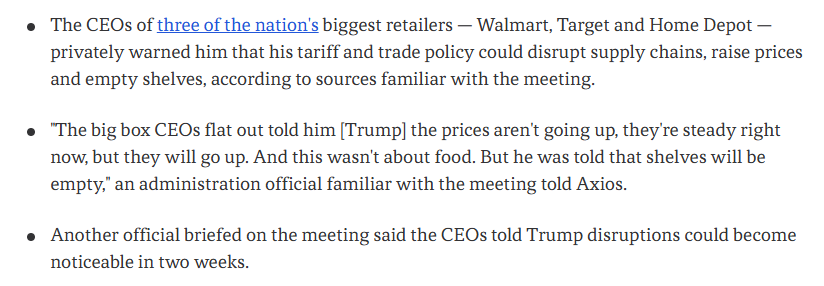So here’s where things stand with America’s experiment in populist economics and all its top-down, interventionist wonders. Thankfully, there are some green shoots of hope!
On the trade front, possible de-escalation. The Trump administration is considering cutting tariffs on Chinese imports, potentially slashing them by more than half to ease trade tensions with Beijing. One option under consideration is reducing tariffs to 50–65 percent or implementing a tiered approach with different rates based on national security concerns.
And as for Trump’s public battle with the Federal Reserve, apparent retreat. The president denied plans to fire Fed Chair Jerome Powell despite White House lawyers privately reviewing legal options for his removal for “cause.” Treasury Secretary Bessent and Commerce Secretary Lutnick warned Trump against the move, citing potential market chaos and legal issues, leading Trump to tell aides he won’t oust Powell.
What explains these moves? Surely, Wall Street and severe market turmoil provide part of the answer. Then there’s what Corporate America is telling the White House, especially as regards the tariffs.

Welcome news, but economic history suggests a degree of inevitability. One of my favorite papers is “The Macroeconomics of Populism,” a 1991 analysis by Rudiger Dornbusch and Sebastian Edwards. Economic populism in Latin America, the economists argue, follows a drearily predictable pattern. Governments blithely ignore fiscal discipline and external constraints while pursuing rapid growth and redistribution. These experiments inevitably flounder as bottlenecks emerge, currency reserves dwindle, and inflation accelerates.
The denouement proves grimly familiar: Capital flight and economic collapse that impoverishes precisely those regular folks the populists promised to help. The authors’ lesson is stark (and all too applicable to current events here in America): Economic policy cannot simply wish away macroeconomic constraints.
A more recent analysis, one just as pessimistic about populist economics, is 2021’s “The cost of populism: Evidence from history.” The researchers assembled a cross-country database, identifying 50 populist presidents and prime ministers in the period 1900–2018. Their conclusion:
When populists come to power, they can do lasting economic and political damage. Countries governed by populists witness a substantial decline in real GDP per capita, on average. Protectionist trade policies, unsustainable debt dynamics, and the erosion of democratic institutions stand out as commonalities of populists in power. … There are only nine cases in which the populists left office in a regular manner. The large majority of exits (32 cases) were irregular, meaning that populist leaders refused to leave office despite losing an election or reaching the term limit (eight cases), they died in office (three cases), they resigned (13 cases) or were forced to resign because of a coup, impeachment or a vote of no confidence (eight cases). … The erosion of democratic norms may explain both the persistence and the negative economic outcomes of populism.
As the Japanese author Haruki Murakami puts it, “In dreams you don’t need to make any distinctions between things. Not at all. Boundaries don’t exist. So in dreams there are hardly ever collisions. Even if there are, they don’t hurt. Reality is different. Reality bites. Reality, reality.”
Constraints, constraints.
The post The Failure of Populist Economics: Then and Now appeared first on American Enterprise Institute – AEI.















